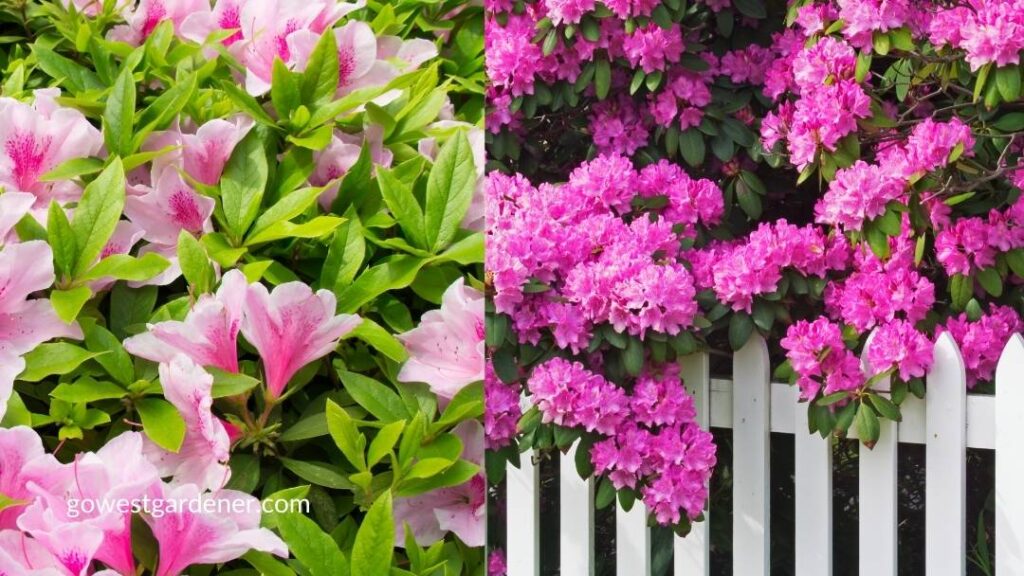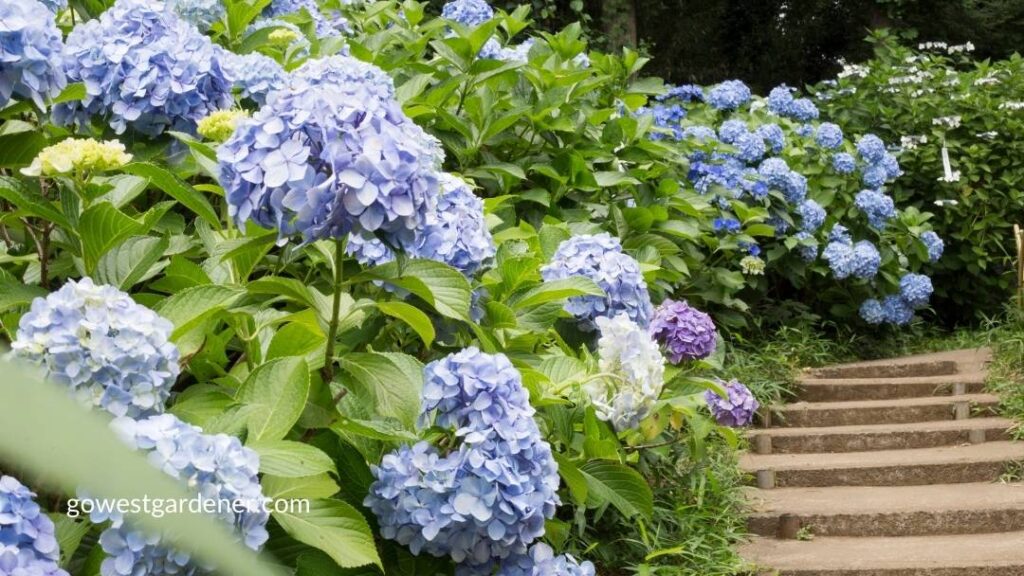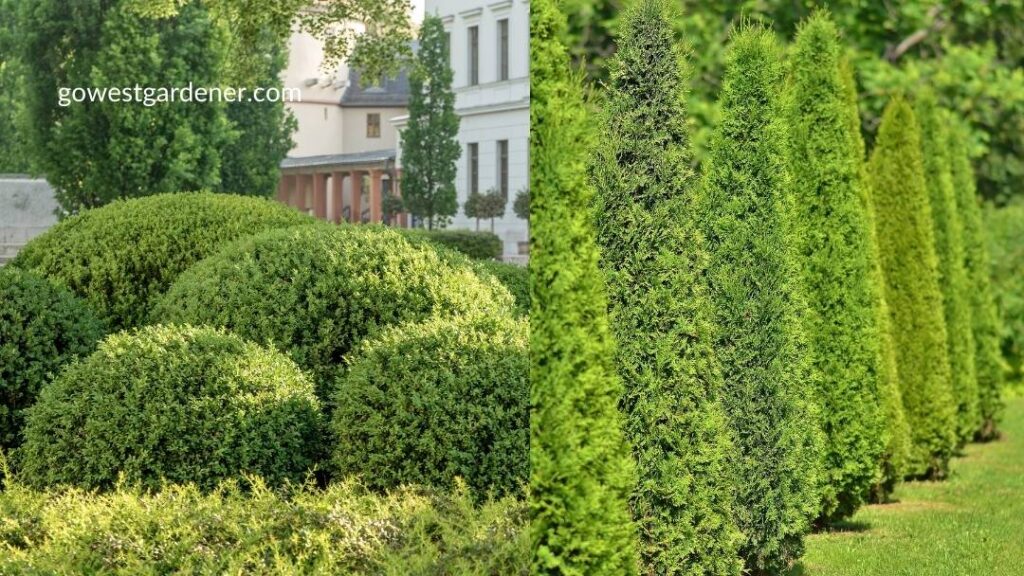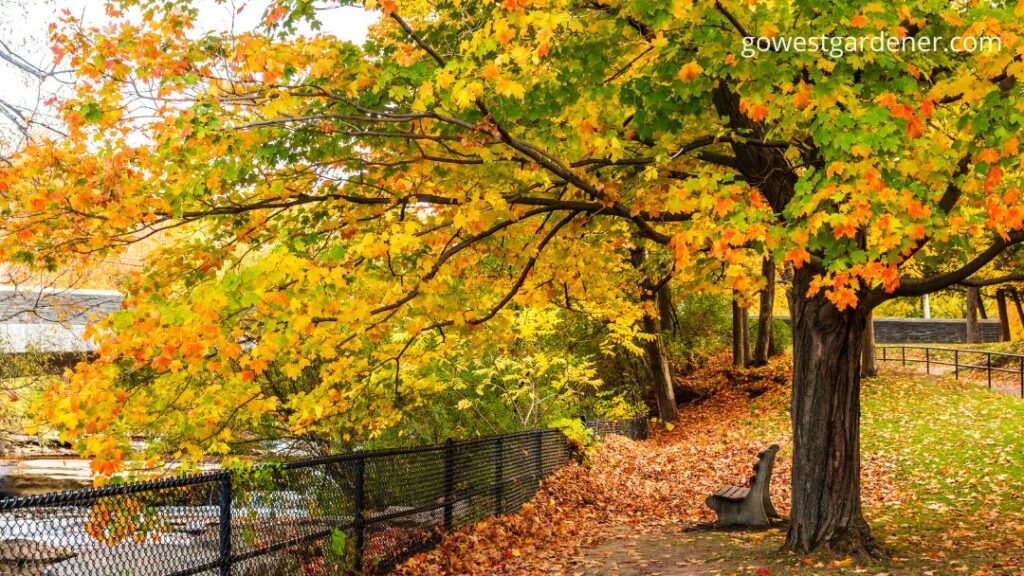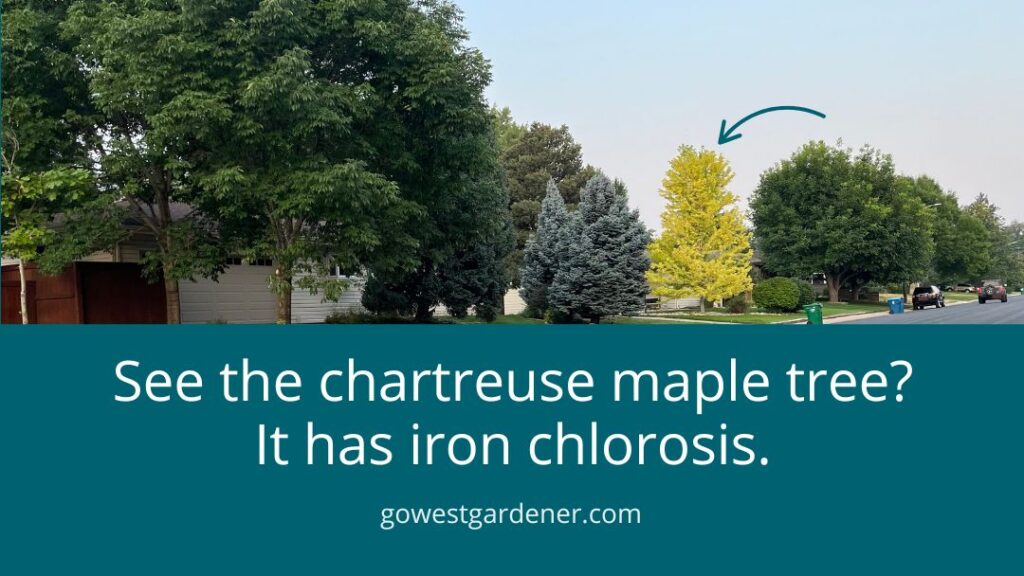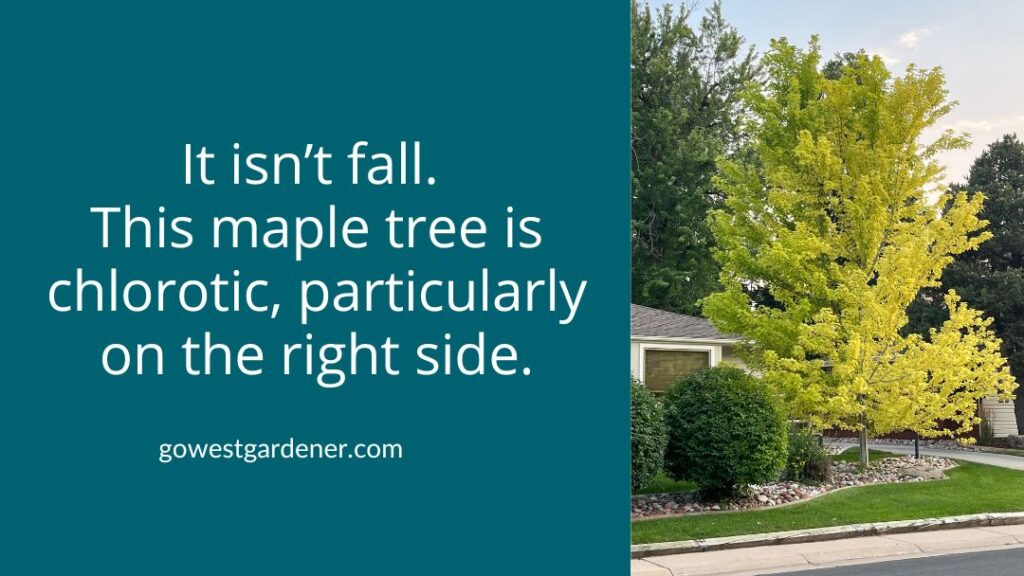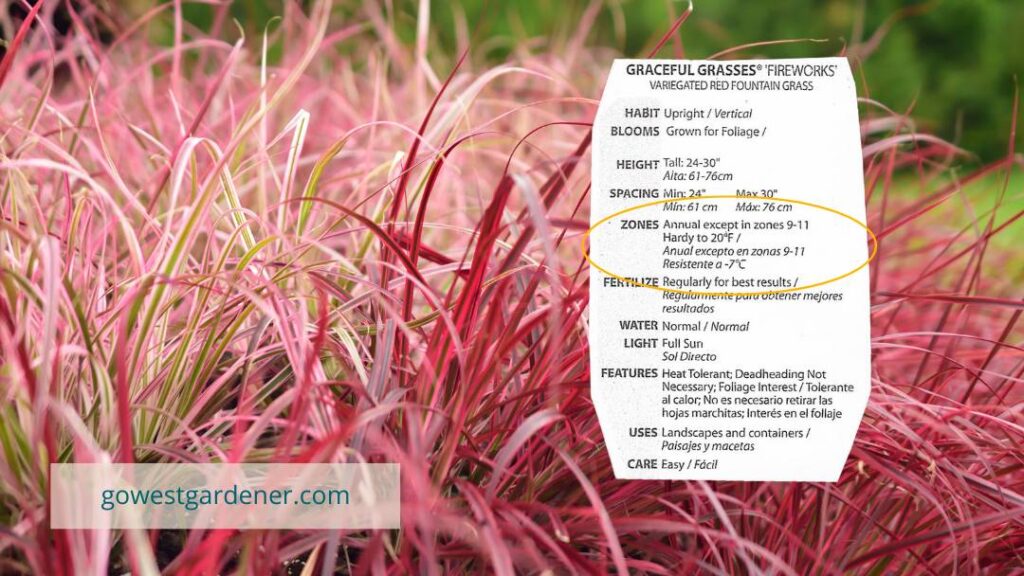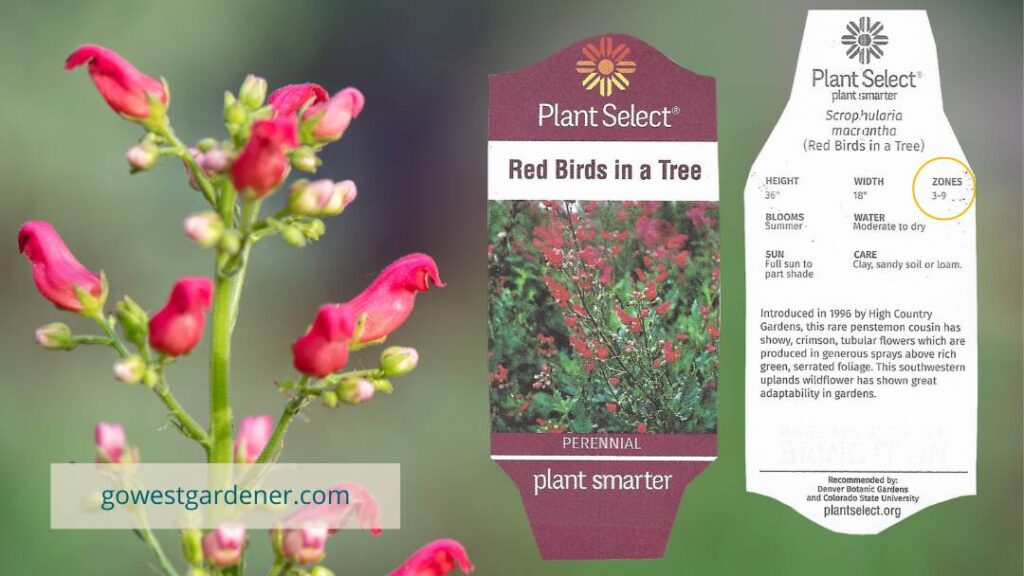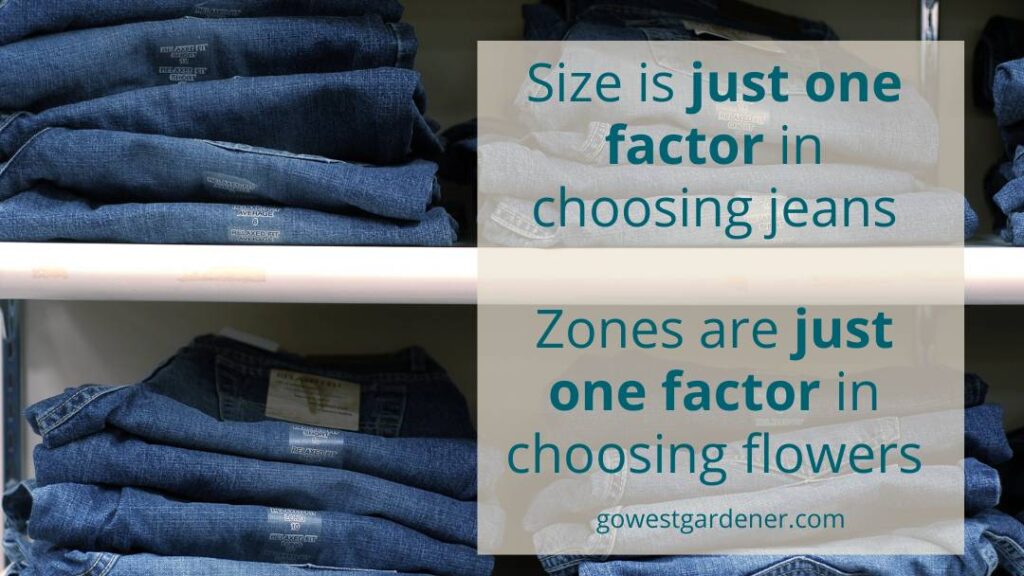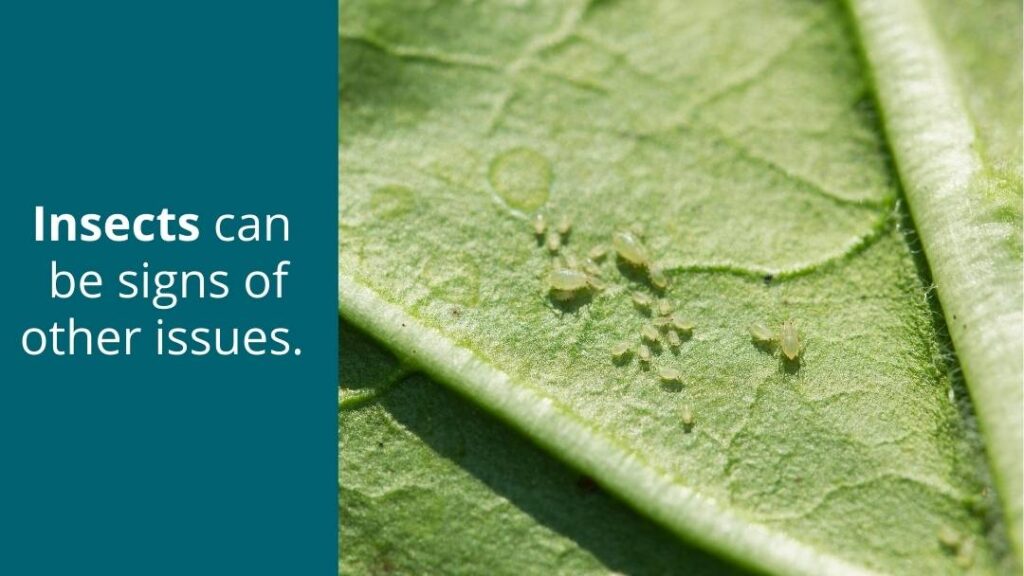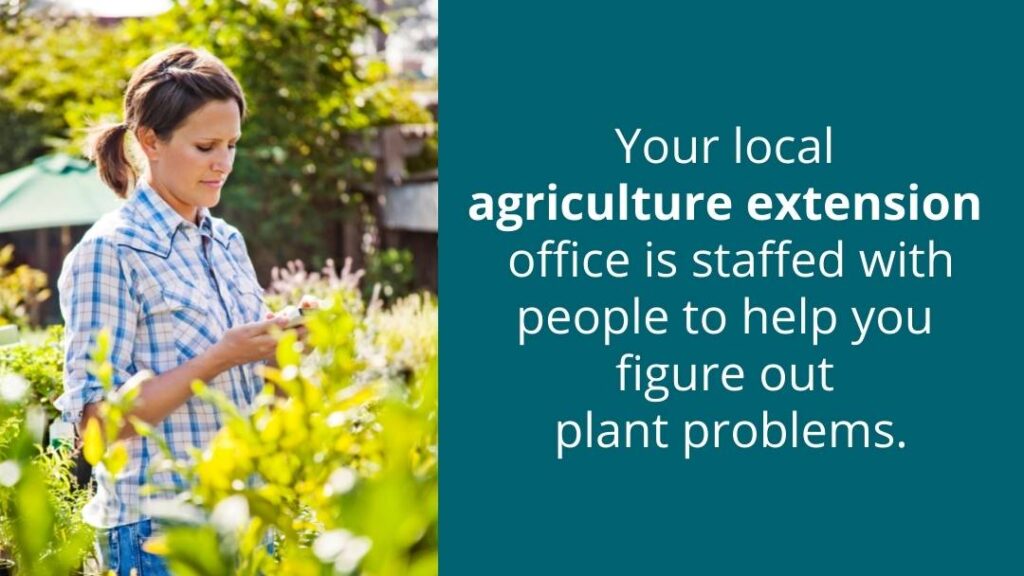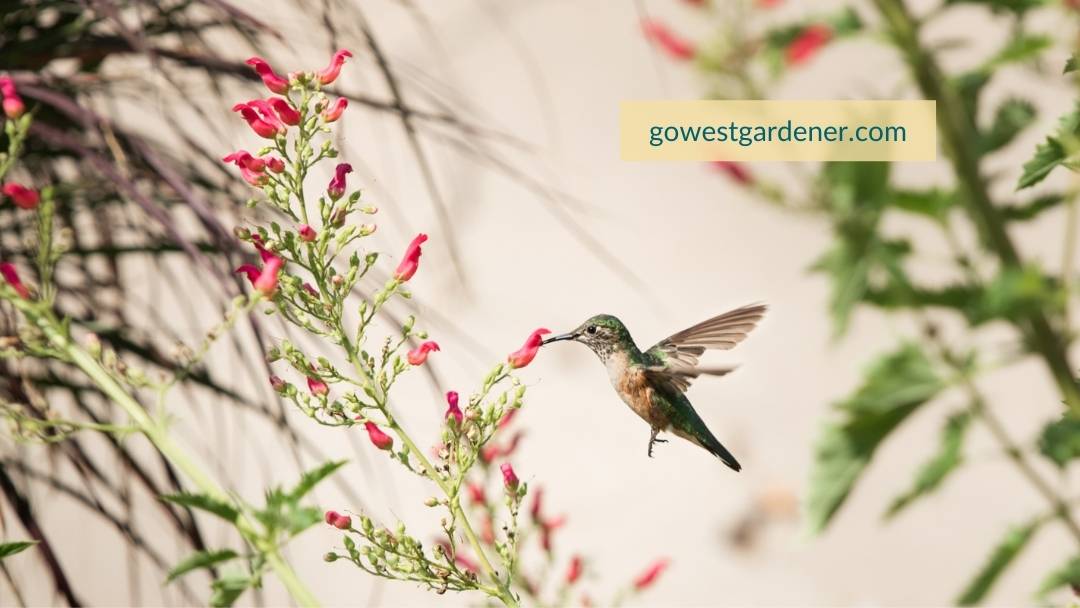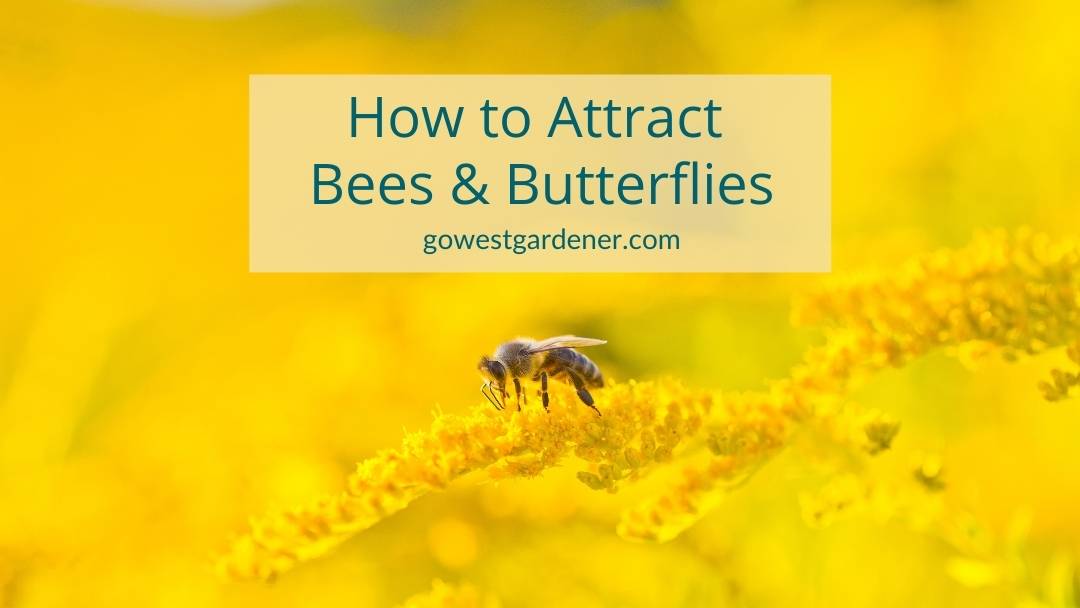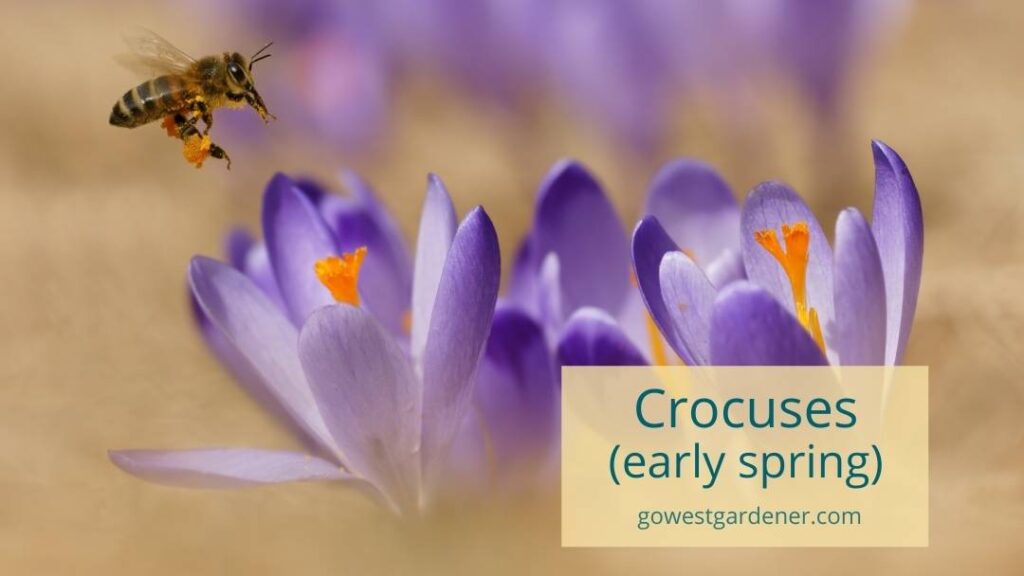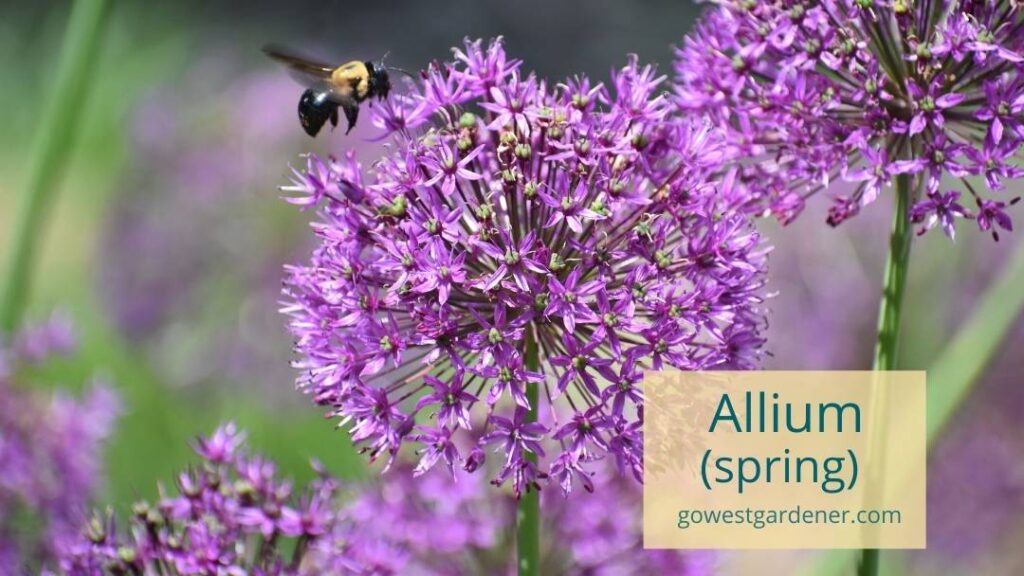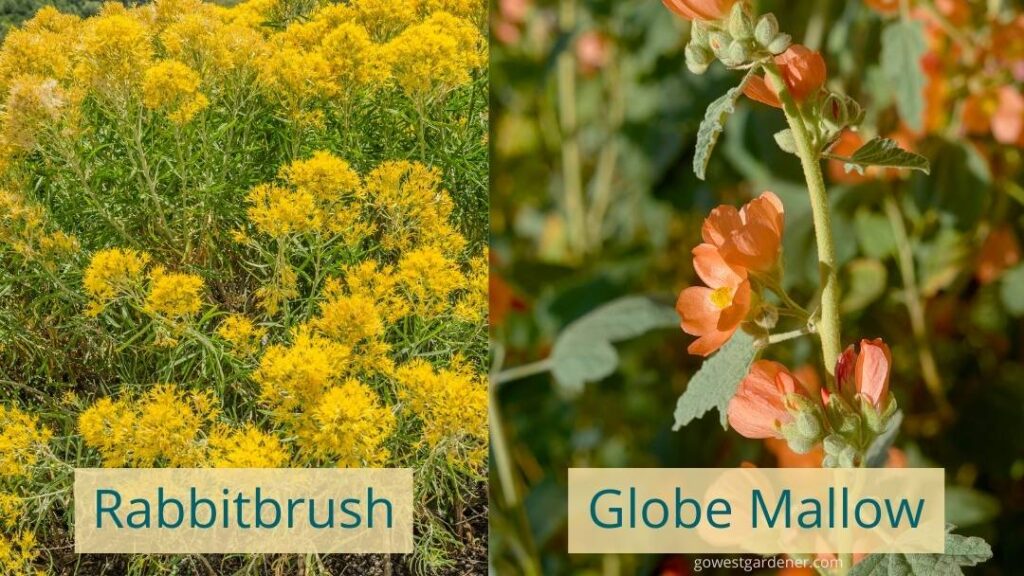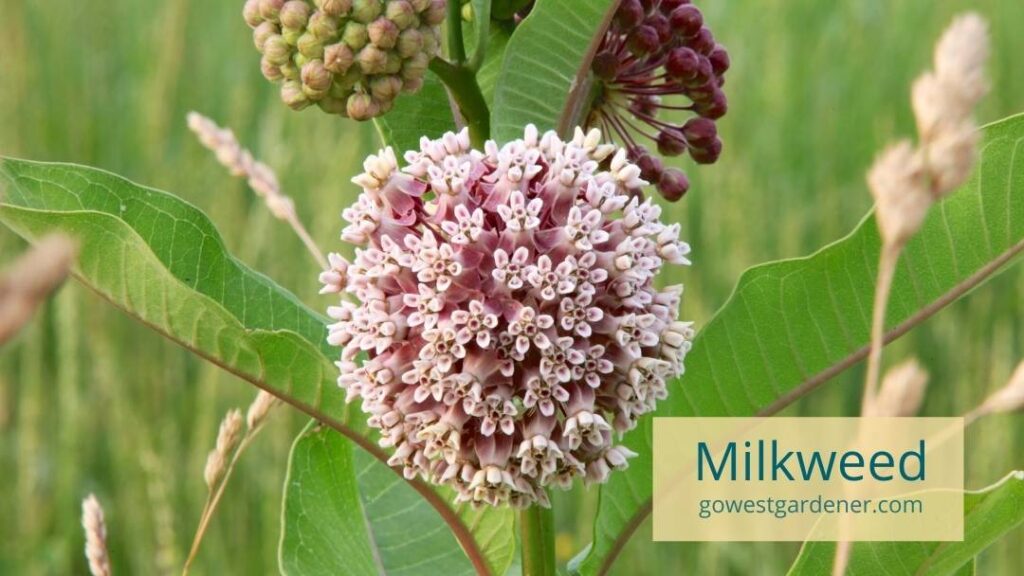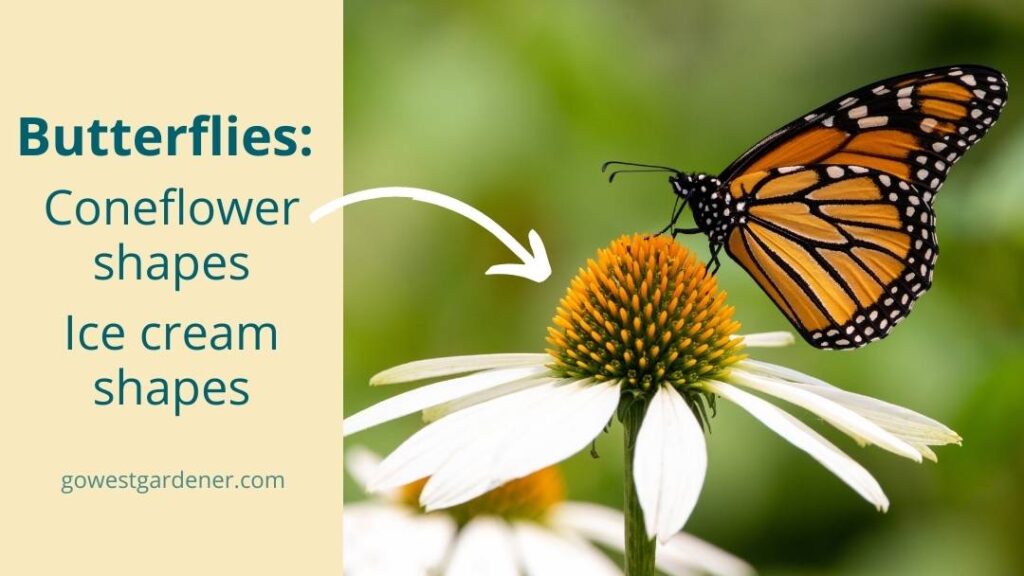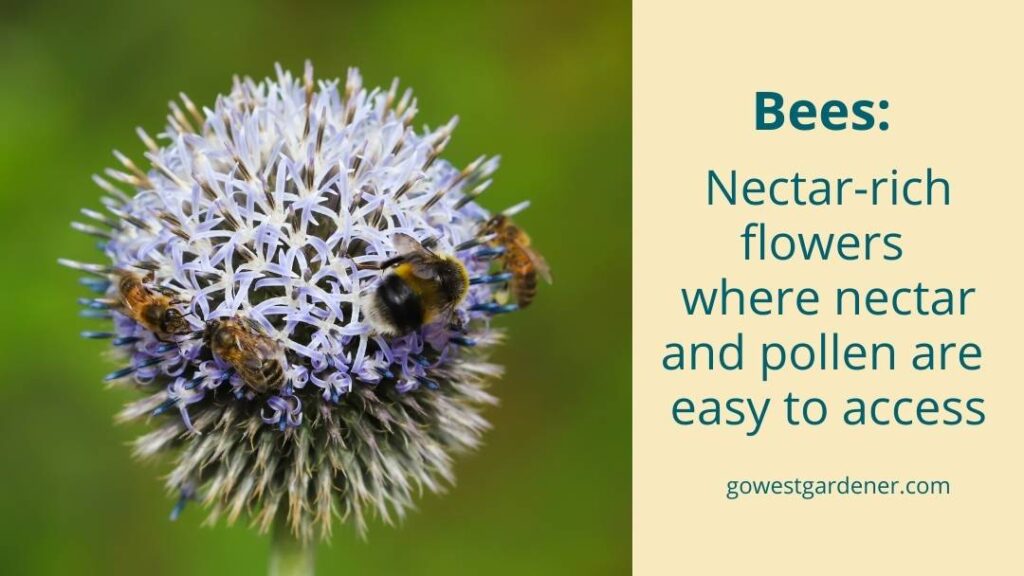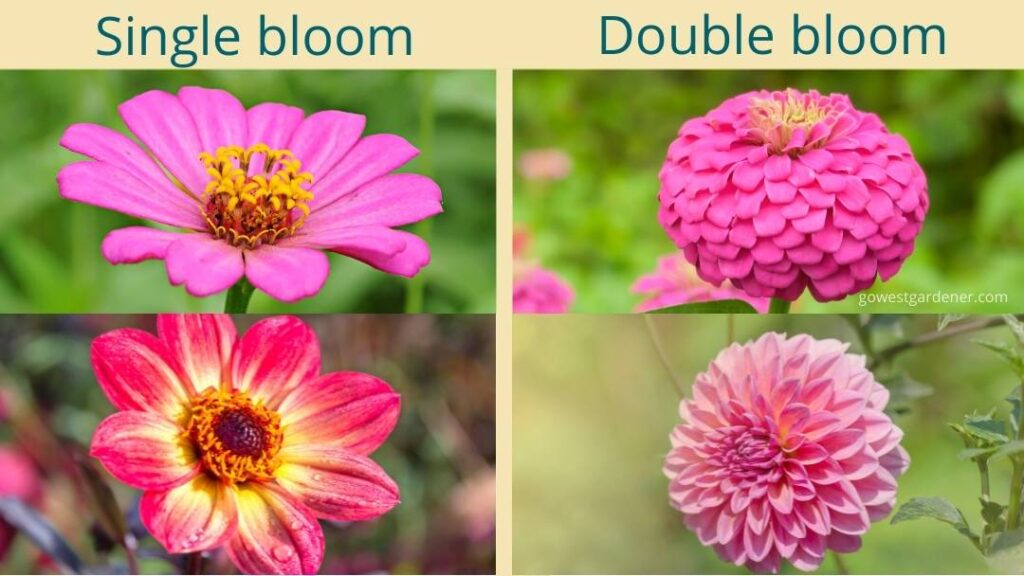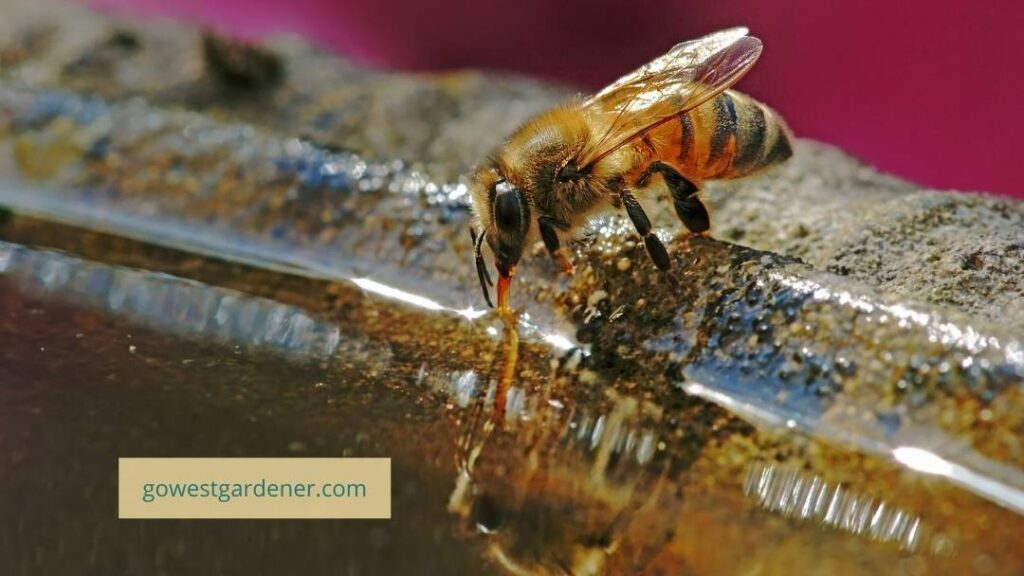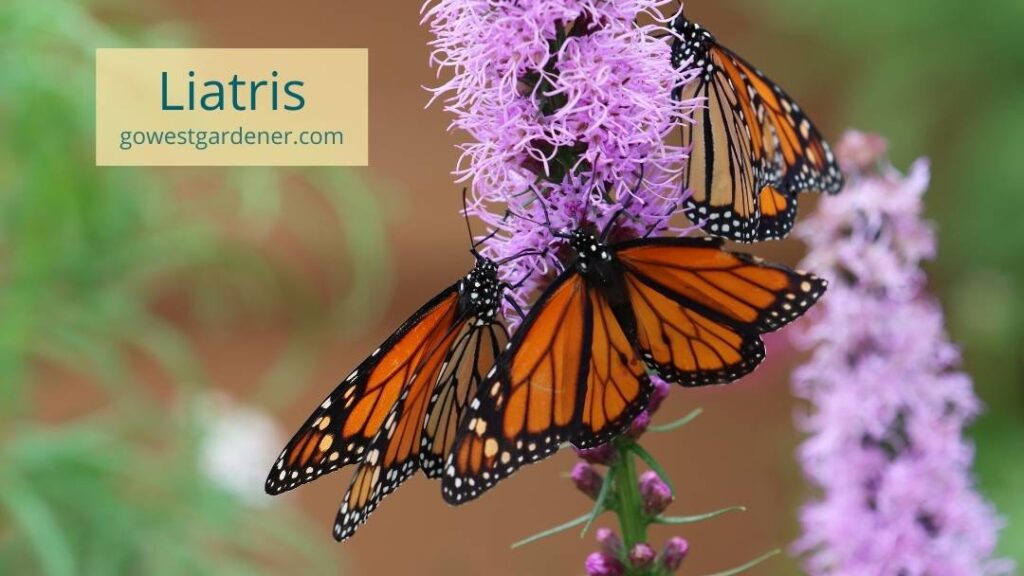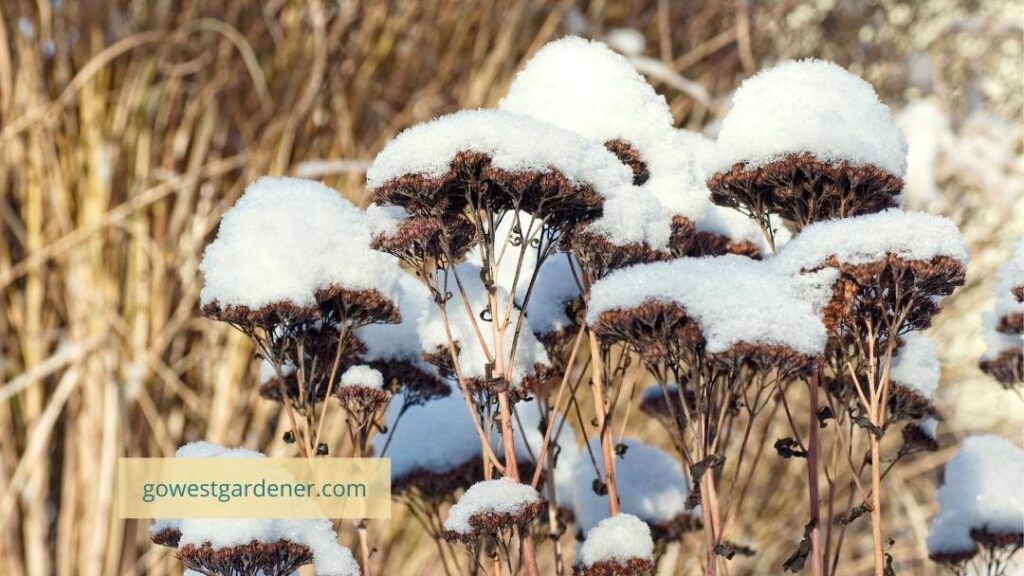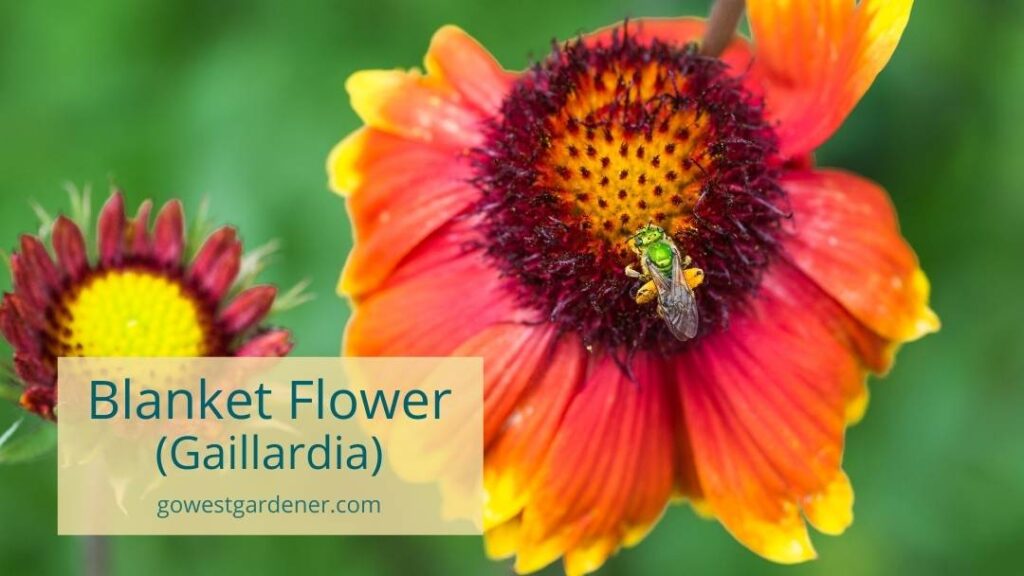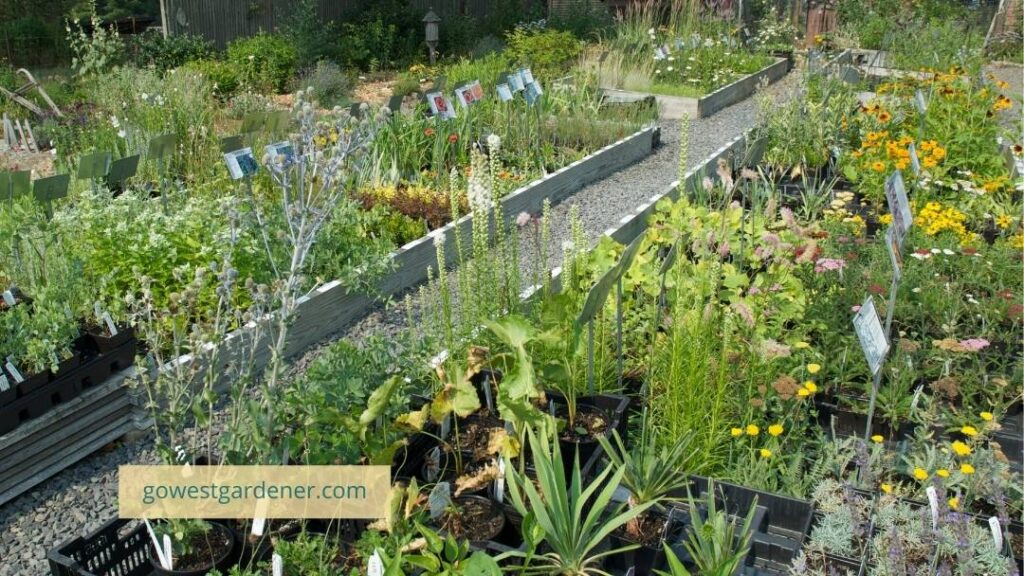
by Ann at Go West Gardener | Updated: Jun 20, 2025 | Best Flowers for Colorado, Utah & Similar States, Waterwise Gardening in the Intermountain West
I received the following question from a gardener who moved to Colorado from New England, and I thought, ooooh, that’s a good one!
“What plants struggle in Colorado?”
Here are some popular plants from other parts of the country that are best to skip in Colorado if:
- You don’t want extra work.
- You’d like to keep money in your wallet.
- You want to be smart with water.
- You’d like your Colorado landscape to consistently look good.
Let’s dig in!

Azaleas and rhododendrons

Azaleas and rhododendrons are flowering shrubs that thrive in parts of the country that get more rainfall and have acidic soil (dirt).You’ll see azaleas growing in gardens along the East Coast and gracing photos in Southern Living magazine. Rhododendrons are popular in the Pacific Northwest.
But azaleas and rhododendrons struggle in Colorado.
Why? Because our soil is too alkaline for them. It’s tough for these acid-loving plants to get the nutrients they need from the ground, and they decline in health.
You may see azaleas and rhododendrons in the box stores and think, “But they look so pretty!”
Keep on walking.
Those stores don’t always have plants that are well suited for our unique growing conditions in the Rocky Mountain region. Azaleas and rhododendrons will have a tough time looking pretty in the ground.
Hydrangeas

Hydrangeas are another type of flowering shrub. The majority don’t fare so well here… with a few exceptions.
But more importantly, hydrangeas need A LOT of water. Heck, they even have “hydra-” in their name!
Hydrangeas need up to 2 inches of water per week in hot and dry weather just to keep from wilting, according to the University of Massachusetts Amherst. Given how hot and dry our summers are, that’s about 20+ inches of moisture in July and August alone.
To put that in perspective, we get an average of 8-16 inches of moisture for the entire year at our lower elevations in Colorado. (The exact amount depends on where you live.) In contrast, Seattle and Chicago get close to 40 inches of moisture per year. Boston gets about 44 inches per year. And Atlanta and Orlando get around 50 inches per year.
Hydrangeas are beautiful… but typically, they are not a great fit for our semi-arid climate.
Boxwoods and arborvitaes

Boxwoods and arborvitaes are decorative landscape plants that are popular in other parts of the country. When they’re healthy, they (typically) keep their color all winter.
But here in Colorado, these evergreen shrubs and trees aren’t big fans of our winters, and they’ll let you know it!
I wrote a whole article on this topic: See why boxwoods and arborvitaes struggle in our Colorado winters >
Many types of maple trees

I grew up in a Midwestern state with beautiful maple trees, so this was a hard one for me when I first moved here.
But many maple trees have a hard time absorbing iron from our soils. They are prone to “iron chlorosis” in Colorado. Their leaves can turn chartreuse green, and they often need to be treated with iron annually, which means you’re shelling out money to a tree company.


They also can struggle in our drought, our big temperature swings and our heavy spring snowstorms.
If you have your heart set on a maple, check out Bigtooth Maples (Acer grandidentatum) and Tatarian Maples (Acer tataricum). Both have a stronger track record than other maples in Colorado. Bigtooth Maples are native to western Colorado and Utah.
So, what does all this mean for your Colorado garden?
You have a choice!
You can absolutely plant any of these plants if you really want to. But if you want an easier time, why not focus on plants that thrive in our western growing conditions?
There are plenty of beautiful western plants to choose from!
Related topics that may interest you:


by Ann at Go West Gardener | Updated: Jan 15, 2024 | Flower Garden Basics
When you buy a flower plant…
You may notice a strange phrase on the plant tag that says: “Hardiness zones” or “Zones.”
If you’re wondering, “What is a plant hardiness zone? What does that mean?”, you’re in the right place.

At its most basic, a plant hardiness zone tells you whether a plant is likely to survive the winter temperatures in your area.
It’s a helpful concept to understand because it can play a role in whether your plants will come back or not.
I like to think of a hardiness zone like a jean size
Think, for a moment, about your favorite pair of jeans.

When you put them on, they fit you like a glove. They feel good. They make you look good. They make your butt look good.
YOU. LOVE. THEM.
Sure, you could wear a size or two bigger, but they just wouldn’t feel right.
And yes, it’s possible you may be able to s-q-u-e-e-z-e into jeans one size smaller — with the help of some serious Spanx or extra reps at the gym. But your jeans REALLY wouldn’t feel right. You wouldn’t last very long in them.
Nope, there’s a sweet spot.
Your favorite jeans are the right size for you.
Your garden is like your beloved pair of denims: It has a sweet spot too
It’s “size” is known as its hardiness zone.
And that zone number tells you which plants should be the right fit for surviving winter temperatures and returning in your garden next year.
You can try planting flowers that don’t fit your garden’s plant hardiness zone, but they’re less likely to return.
Luckily, you don’t have to become a meteorologist to figure out your zone

The U.S. Department of Agriculture (USDA) created a simple way to help you choose plants for your garden.
It’s called the “USDA Plant Hardiness Zone Map.”
Basically, they’ve assigned a zone to where you live. Your zone is based on the coldest temperatures that are expected in your area.
As long as you choose plants that match your zone, your plants should be strong enough to survive winter temperatures in your area.
The opportune word here is “should.” Hardiness zones are based on the expected coldest temperatures in your area. However, Mama Nature has been known to push the boundaries of coldest temps — like the arctic blast that swept much of the U.S. in February 2021. Plus, there are other factors that can come into play on whether your plants survive winter in the West. The key takeaway? While plant hardiness zones are helpful, they aren’t perfect.
Let’s look at the USDA Plant Hardiness Zone Map

You may notice that the coastlines (in oranges and yellows) tend to have warmer winters than the upper-central portion of the United States (in greens, blues and purples).
That’s because the oceans help moderate winter temperatures.
In the Rocky Mountain region of the country, we have a WIDE range of plant hardiness zones. It depends on where you live.
For example, let’s say you live in the Front Range of Colorado. Most areas along the Front Range are in Zone 5. The lowest extreme temperatures you’re expected to get are -10 degrees to -20 degrees Fahrenheit below zero.

You can find your plant hardiness zone on the USDA website
Okay, you’ve looked up your zone number…
Now what the heck are you supposed to do with it?
When you go to buy flowers, look for the zones on the plant tags (tucked in the containers).
If you want your plants to come back next year, pick flowers that match YOUR zone number.
For example, let’s say you live in Zone 5
You see this red fountain grass (below) at the store, and you’d love to plant it in your garden. The plant tag says it’s “annual except in zones 9-11.”
This plant tag is telling you that this grass will likely only survive winter temperatures in Zones 9-11.
Because you are in Zone 5, this plant will look great in your garden for one summer, but it should NOT come back next year. It isn’t “cold hardy” where you live.
Let’s look at another example
You like the look of the plant below called Red Birds in a Tree. (By the way, this is one of my favorite plants in my garden. My neighbors always ask about it, and the hummingbirds LOVE it!)
The plant tag for this flower says, “Zones 3-9.” Do you see the zones below?

In our example, your garden is in Zone 5, so this plant SHOULD return next year. It should come back in any of the Zones 3-9.
Use your zone to be a smarter plant shopper
When you buy plants that you want to return every year:
- Don’t assume that the plants at the store are right for where you live.
- Check the plant tags to make sure their plant hardiness zones match yours.
- If you’re buying plants online, look for each plant’s hardiness zone in the online description of the plant.
If you pick a plant that doesn’t match your zone, you may find yourself a replacing dead plant next year!
While your plant hardiness zone is helpful, it’s only ONE part of choosing the right flowers for your western garden
Remember that your plant hardiness zone is like your jean size.
When you’re buying jeans, the size is important, yes.
But you probably care about other things too — like the the length, fit and color.
If you’re 5’3′, tall jeans are going to create unnecessary work for you.
And we do not want unnecessary work!

In your western garden, you also want to know:
- How much water your plants need (can they tolerate semi-arid conditions and drought?)
- How well your plants can handle intense sunlight (at elevation, we’re closer to the sun, so our sunlight is tougher on plants)
- Your plants’ tolerance to things like hail and wind
- What kind of soil the plants like
- And more
Here’s an example of what can happen if you only think about your plant hardiness zone.
Again, let’s say you live in Zone 5.
If you ONLY consider your plant hardiness zone when choosing flowers, you may find yourself planting the same flowers that thrive in humid, rainy, coastal Maine.

Not the best idea for your semi-arid garden in Colorado or Utah, right?
It’s helpful to choose flower plants that fit your zone, but know that your zone is only one part of finding the best flowers for your western garden.
Related tips that may interest you:


by Ann at Go West Gardener | Updated: May 8, 2023 | In-ground garden, Western Container Gardening With Flowers
Looking for an easy-to-grow flower that gives you big, pretty color in the late summer?
I’d like to introduce you to Black-Eyed Susan (officially, Rudbeckia — Rude-bek-ee-uh). It also goes by the name: Gloriosa Daisy.
There are MANY reasons to love this flower.
In this article, we’re going to chat about why Black-Eyed Susan plants can be great flowers for late summer gardens in the West.

More than a month of colorful blooms? Yes, please!
If you’re new to Black-Eyed Susan, it’s a showy flower that resembles a daisy.
It often has gold or yellow petals and a black, brown or green center.
Typically, in states like Colorado, it will bloom in late July, August and even early September, so it gives you pretty color when a lot of other flowers are done blooming.
The exact bloom time depends on where you live.
Here are reasons to include these pretty flowers in your western garden:
- They’re bright and showy, adding a BIG pop of gold color to your garden in mid- to late-summer.
- They bloom for a looooong time. You may get up to 2 months of color.
- Some grow well in mountain gardens, as well as down at lower elevations.
- They tend to be adaptable to our tricky western soils, from clay soil, to sandier soils.
- They grow well in the sun, but some will tolerate places in your garden that get a mix of sunshine and shade.
- Some are drought tolerant once they’re established. (Ideally, though, many of them prefer moderate water. You may want to plant them near a downspout or in a low area that stays more moist.)
- They don’t like a lot of fuss. They’re usually happier without things like fertilizer.
- They tend to be deer-resistant, meaning these plants aren’t Bambi’s first choice for breakfast.
Translation: This is an easy-going, low maintenance plant for western states like Colorado and Utah.
And cheers for plants that aren’t a lot of work, am I right?

But here’s what doesn’t always get mentioned…
Some types of Black-Eyed Susan are shorter-lived than others.
I share this with you because if your plant doesn’t come back, you may think you did something wrong.
But nope, you may have just purchased a shorter-lived Black-Eyed Susan! Find out how to tell them apart here.
Related topics that may interest you:


by Ann at Go West Gardener | Updated: Jun 20, 2025 | Best Flowers for Colorado, Utah & Similar States, Gardening for Pollinators, In-ground garden, Waterwise Gardening in the Intermountain West
Would you like a long-blooming perennial…
… that attracts butterflies and interesting moths, gives you color all summer AND is drought tolerant?
Yes, pleasssssse!
I can’t wait to introduce you to Jupiter’s Beard (aka, Red Valerian). Its botanical name is Centranthus ruber.
If you want months of color, I think it’s one of the best flowers for Colorado, Utah and similar western states. It’s one of my favorite perennials. (Perennials are the flowers that come back year after year.)


Here are a few reasons to add Jupiter’s Beard to your garden.
This flower plant is:
- Easy to grow
- Colorful and showy
- Drought tolerant (you don’t have to water it much once it gets established in your garden—awesome for semi-arid states like Colorado and Utah)
- Tolerant of hail (it bounces back quickly from light hailstorms)
- Resistant to nibbling deer and rabbits (they tend to skip it for munching)
Plus, it’s a MAGNET for butterflies and interesting moths.
I constantly find myself heading back into my house to get my camera because there’s a new butterfly dancing across its flowers.
“Oh, hey there, Swallowtail butterfly!”

The Monarch butterfly in the photo below visited my Jupiter’s Beard plant in October.
(Yep, flowers and butterflies well into October!!)

And its color goes on, and on, and on …
When you’re planning a perennial garden, I think one of the biggest challenges can be finding flowers that give you showy color for a long time. Most perennials only bloom for a few weeks, and then they’re done for the season.
The beauty of Jupiter’s Beard is that it will keep pushing out new flower blooms over the whole summer.
The only catch is that you need to keep up with trimming off the faded blooms, so new buds can grow in.

And if you don’t trim off the dead blooms?
Well, this happy-go-lucky plant will send its seeds EVERYWHERE.
It’s like a birthday card with glitter on it. No many how many times you vacuum, you keep finding more glitter.
Friends, the seeds on this plant are like glitter.
So, put Jupiter’s Beard in a spot you want to fill in with more flowers OR be diligent about trimming off the dead blooms.
You can find Jupiter’s Beard with red, pink or white flowers.
The red variety is more of a dark pink than a true red, but it’s still very pretty.

Jupiter’s Beard is happiest when it gets a lot of sunshine (6+ hours/day).
It grows well up to elevations of about 9,000 feet.
And if you’re familiar with plant hardiness zones (which tell you whether a plant is likely to survive winter temperatures in your area), Jupiter’s Beard typically grows well in gardens in zones 4-9.

Do you live outside the intermountain west?
If you live in another region of the country, ask at your local garden center whether Jupiter’s Beard can be grown where you live.
Jupiter’s Beard can spread aggressively in maritime regions (like the West Coast), so there are places where it isn’t allowed.
Related tips that may interest you:


by Ann at Go West Gardener | Updated: Sep 16, 2025 | Gardening Tips and Tricks, Western Container Gardening With Flowers
You want to “clean” your petunias, so they look pretty and tidy.
But how do you know you’re trimming off the right parts? What’s a new bud versus a dying flower?
In this short video on petunia care, you’ll see get simple tips and clear photos on:
- EXACTLY what to look for on your petunia plants, so you don’t cut off the wrong parts
- The key differences between dying flowers and new buds
- What a seed pod looks like (and why you want to remove it)
And if you have flowers that look like mini-petunias — which you may know as Million Bells, Super Bells or Calibrachoa — this video can help you too.
Click above to watch.
Prefer to read?
Simply scroll down for the transcript.
TRANSCRIPT:
How to Care for Petunias, So You Aren’t Trimming Off the Wrong Parts
How do you tell the difference between a new bud and a dying flower on your petunias?
It’s not always easy to tell.
That’s what we’re going to talk about in today’s tip.
[music]
Hi, I’m Ann with Go West Gardener.
Inspiring new western gardeners to find their green thumbs with flowers.
It’s awesome that you want to clean your petunias, so they can grow new flowers for you.
But, at the same time, you want to make sure you aren’t cutting off new blooms by mistake!
First, if you are ever unsure whether you’re looking at a bud or a dead flower, I say, give it a couple of days.
Because within a few days, it should become more clear.
If the bloom is dying, the petals will look more dry and even more shriveled up.
And if they’re new buds, they’ll look even bigger, and they should have more color to them.
You’re going to see some changes.
But let’s say you want to know now.
Here are some ways to tell.
It helps to think about a petunia bloom as a torch and a flame.
The little stem is the torch and the petal is the flame.
One of the easiest ways to tell if the flower is ready to be trimmed is you will have a shriveled up flame sitting on a torch.
The petals, which we’re calling the flame, will be curved over.
They’ll often change color, getting really dark or brown or gray.
And they’ll almost feel like shriveled up paper.
Another thing you may see is just the torch.
The petals have fallen off on their own.
The torch doesn’t have any additional leaves on it.
It’s often pretty long, and it connects at the stem.
Even if the flame is gone, it helps to trim off this torch because if you don’t, the torch may begin forming a little green kernel in the middle.
This is a seed pod, and it means your flower is turning its attention away from making flowers.
And we want flowers!
Let’s look at another example.
Can you see the torches on this petunia that are ready to be trimmed?
There’s this one here.
It’s the most obvious because it has a shriveled up flame.
But you’ll also see a torch here.
Here.
Here.
And here.
These are all ready to be trimmed off the plant.
If you haven’t been trimming off the torches, the first time you clean up your petunias, you may find yourself cutting off a lot of them at one time.
It helps to trim them off as you see them.
This will help keep your petunias’ energy focused on making new flower buds, rather than going to seed.
But let’s go back to our example for a second.
There are also new buds on this stem.
Here.
And here.
What are some clues that they’re new?
You’ll often see leaves on them.
The torch is just opening up.
And often times, the torch stem is still really short in length.
Okay, so let’s talk for a second about the in-between phase when the petunia flame is either getting ready to bloom or it’s dying.
To tell if it’s a new petunia flower, there’s a lot of structure to it.
You’ll see the bud is pretty firm.
I like to think of it as being architectural.
It kind of looks like a drill bit.
You’ll see a clear structure to it at the top of the bud.
And the flower opens in a distinctive pattern.
In contrast, though, a fading bud – that’s one that’s dying – doesn’t have as much shape to it.
It’s soft, kind of a blob, and it’s starting to shrivel.
Can you see the difference?
If you’d like more ways to feel more confident with gardening in the West, please click to subscribe to this channel [on YouTube].
See you next time.
[music]
Related topics that may interest you:


by Ann at Go West Gardener | Updated: Jun 20, 2025 | Gardening Tips and Tricks
There is no perfect gardener, no matter what your neighbor up the street with the pristine landscape wants you to think.
So, if you have a flower that looks sick, is struggling or is dying, take heart. It happens to everyone.
(Yes, even to your neighbor. Though, she may not admit it!)
Flowers can get stress, weather issues, disease, insects…
And that’s just the beginning.
The tricky thing is that sometimes the issues you see AREN’T the primary issue.
They’re signs or symptoms of an underlying problem.
Insects, for example, are known to show up when a plant is stressed and something else is going on.

So, wouldn’t it be awesome to have a plant detective to help you figure out what’s going on?
Good news, you DO have a local resource if you need plant help.
But you may have never heard of it before!
It’s called an agriculture extension office or a cooperative extension.
The lingo can vary slightly from state to state.
These offices are usually associated with a state university.
They’re staffed with horticulturalists and trained volunteers who are there to help you figure out what’s going on with your plants.

Pretty cool, right?
You can reach out to them by email or phone. Some have locations you can visit.
Usually, they’ll ask questions to help you identify what’s going on with your plants. If there are solutions, they’ll help you understand what to do. And it’s all based in research and science.
This service is typically free or available for a very small fee.
So, how do you find your local extension office?
Here are links to the cooperative extension offices in western states:
If you don’t see your state listed above, search for: [your state] agriculture extension office.

When you open your state’s website, look for the extension office for the county you live in. Generally, it’s best to start with your county’s office.
If you don’t see your county, look for a nearby community.
Before you reach out, you may want to collect a few pieces of info.
1) Take clear photos of what you’re seeing on your plant.
Include a close-up photo, a slightly wider shot and a very wide shot of your yard.
Sometimes the issue on your plant is related to something else that’s going on in your garden environment.
Plus, photos can be helpful for identifying your plant, whether it’s a flower, vegetable, shrub or tree.

2) Make notes about what you’re seeing.
This makes it easier for someone who isn’t there by your side in your garden to understand what’s going on.
For example:
- What are you noticing?
- When did you first notice it?
- Did it happen suddenly or gradually?
- Where is this plant growing in your landscape?
- Have you noticed the issue on any other plants?
- Has anything happened recently in this area?
- Have any fertilizer, weed killers or other products been used around this plant? If yes, what kind?
- How are you watering this plant? How often?
- When was this plant planted?

Thinking through these questions in advance can be helpful.
And if you aren’t sure what the name of your plant is or you don’t know some of the answers, don’t worry! That’s okay.
3) Collect a sample.
If your plant looks diseased or like it has insects, take a sample and immediately seal it in a plastic bag.
For example, it may look like your plant has diseased leaves. Trim off a section of that plant (some leaves and stem) and seal it in a bag.
Why a sealable bag?
If you have insects, those lil’ critters move quickly. If you put your sample in a paper bag or something open, many will turn into escape artists.
Do you need to pull this info together before you reach out?
Nope! But if you’re chatting with your extension office through email, this can eliminate the need for a lot of back-and-forth messages.
You’ll make more efficient use of your time.
Plus, this background information can help your local extension office give you a more accurate diagnosis of what’s going on.
Don’t hesitate to contact your local extension office.
You don’t have to be a gardener with tons of experience to contact your local extension office.
If you have flowers that look sick or are dying OR you have another pressing plant or yard question (for example, you’re having a hard time getting rid of a weed), it’s 100% okay to reach out.
Your extension office should be there to help you without judgment.
Related topics that may interest you:


by Ann at Go West Gardener | Updated: Jun 20, 2025 | Gardening Tips and Tricks
What the heck is turning your plants into lace-y skeletons?
If it’s late June, July or August in the Front Range of Colorado, Japanese beetles may be to blame.
“What do Japanese beetles look like?” you may be wondering.
Japanese beetles are metallic green insects with dark orange wings, making their backs look metallic orange. They have white spots along their sides.
And they will eat their way through your yard with reckless abandon.

Japanese beetles are spreading along the Front Range of Colorado, including the metro Denver area, parts of Pueblo, Boulder and Ft. Collins.
So, what can you do about Japanese beetles?
It’s 100% normal to go out and buy the first products you see to get rid of Japanese beetles.
But, while these products may be well intentioned, many have not proven to be effective in reducing damage on your plants. You may be throwing away good money.
And some products are very toxic to the good insects in your garden, like bees. You may be unintentionally nuking your own garden.

In this video about Japanese beetles, you’ll get:
- A basic introduction to Japanese beetles, so you know what to expect
- 2 primary ways to think about Japanese beetle control, so you use your time well
- A look at some of the plants they REALLY like
- Myths about ways to get rid of Japanese beetles, so you don’t waste your money on products that don’t work
- A more detailed resource, if you want it, that includes Japanese beetle control products on the market
Prefer to read?
Scroll down for the transcript.
I’ve also included helpful resources at the end of this article, including different products you can use to control the beetles.
Transcript of Japanese beetle video:
Japanese beetles in Colorado.
They’re working their way up and down the Front Range.
These beetles can be a royal pain in the bootie for your flowerpots, your garden, your trees and even your lawn.
So, in this video, you’re going to find out what you should know about Japanese beetles in Colorado and how to control them.
[music]
Hi, I’m Ann with Go West Gardener.
Inspiring new western gardeners to find their green thumbs with flowers.
Real quick, in addition to my 15 years of hands-on experience with gardening in Colorado, I’ve completed more than 120 hours of formal training in western gardening, and I continue to take courses and workshops, so I can help you with topics like the one today: Japanese beetles in Colorado.
Unfortunately, Japanese beetles are here to stay along the Front Range. So, it’s helpful to plan ahead and know what your options are.
In this video, I want to give you:
- A basic introduction to Japanese beetles because there’s A LOT of misinformation out there.
- I’m going to share 2 primary ways to think about Japanese beetle control.
- I’m going to debunk some myths about ways to get rid of Japanese beetles. (And yes, you will see your neighbors doing these things.)
- And I’m going to point you to a more detailed resource, if you want it.
Let’s jump in.
Japanese beetles go through a one-year life cycle, but if you have a yard you care about, the real “joy” with beetles comes in the second half of the summer in Colorado.
Around the very end of June or early in July, the adult beetles will emerge from your lawn and start showing up on your plants.
And now they’re ready to eat their way through your garden in July, August and sometimes early September.
Japanese beetles have two priorities:
- To eat and
- To reproduce
If you had them last year, you know they will chew their way through your plants, creating holes in your plants and turning them into lacey skeletons.
Depending on the plant, they may eat the flower petals, they may eat the leaves, or they may eat both.
And between their dinner parties on your plants, the females will fly down to your lawn, dig a few inches down to lay eggs, and then come back up and start the process all over again.
So now, you don’t just have the adult beetles to think about, you have their babies too.
As the eggs hatch, the larvae — which are these little white grubs — will feed on the roots of the grass in your lawn.
And they’re especially fond of lawns that we have along the Front Range of Colorado, like Kentucky bluegrass, fescue and ryegrass lawns.
So, picture this…
You’ve got the adult beetles chewing on your plants above ground, and you’ve got their babies — these little white grubs — chewing on the roots of your lawn.
Not a good time!
As temperatures drop, the grubs will dig deeper into your soil for the winter and then come up closer to the surface again in the spring before they emerge as adult beetles in late June and early July.
So, if we’re going to talk about how to control Japanese beetles in Colorado, it helps to think of them as affecting your yard in two ways:
- You’ve got the adults eating your plants, and
- You’ve got the grubs chewing on the roots of your lawn
From a control and treatment perspective, you can deal with the adults, and you can deal with the grubs.
Let’s talk about how to control the adults that are eating your plants.
One of the biggest things you can do to PREVENT damage is avoid planting flowers and trees that Japanese beetles love in Colorado.
These are plants like roses, Virginia creeper (it’s a vine you’ll see growing along fences), linden trees and some types of fruit trees.
I had a plum tree that the beetles would just fall out of and land in your hair, like the tree was dripping with insects.
It was so gross.
And that’s just the start of what they like to eat.
Every year I feel like I find them on something new.
But let’s say you absolutely love a plant, like roses, and you want to plant them.
Then just know that your roses will look great early in the summer, the beetles will try to chew them up in the middle of the summer, and then, it’s possible your roses may give you flowers again in the early fall after the adult beetles have died.
Now, you may be thinking, so prevention is great, Ann, but I have beetles NOW.
“What can I do about them?”
“How do I get rid of them?”
“Can’t I just spray them?”
Yes, there are insecticides and some bio-controls you can use to kill Japanese beetles.
But do your research because many of these also have a negative effect on bees and other pollinators — the really good insects in your garden that we need.
Later in this video, I’m going to share a resource where you can find a list of product options for you on what you can apply to your plants, including how toxic they are.
If you DO have beetles and you DON’T want to use poisons, one of the most effective things you can do is to put on a pair of garden gloves, put together a container of soapy water, and then knock or pick and drop the beetles into the soapy water to drown them.
(This works with small amounts of beetles.)
Dig through your recycling bin to find a container you can use.
I will often save an empty, plastic butter container that I fill up with soapy water.
I plop the beetles in and then put the top on until I know they’re dead.
Once the beetles are dead, you can throw them out in your trash, you can compost them, you can even bury them — they won’t cause any harm at that point.
When the beetles are chewing on your plants, your plants are releasing a compound that’s like a magnet to more beetles.
For me, this always makes me think of the local ice cream truck.
On summer nights, it comes cruising through our neighborhood, playing that distinctive musical jingle, and the kids come running to it.
So, your plants are basically doing the same thing as that ice cream truck playing that song, and the beetles don’t want to miss it.
Here’s what this means.
It’s better to get the beetles early before you have a feeding frenzy on your hands.
If your plants haven’t been damaged too much yet, it’s like the ice cream song is really quiet. But if you wait until your plants have a lot of damage — the music will be blaring and more beetles will come.
Beetles are groggiest at cooler times of the day and when it’s darker, like in the evening or early in the morning, so those are the best times to try to pick them off your plants.
If you try catching them during the day when it’s warm, they’ll quickly fly away. I have to say, this doesn’t stop me from trying to catch them, but I often miss many of them.
Okay, so that’s one option.
You can pick off the beetles by hand.
But let’s say you have A LOT of beetles, like on your roses or on your vines.
I recently took a Colorado gardening course where the speaker was talking about using a shop vac to vacuum up the beetles from the vine that the beetles were eating.
I have not tried this, but it sounds interesting if you have too many beetles to pick off.
And you know what I’m talking about when you have 5 beetles the first day, and then 20 the next day, and then 172 the next day.
The beetle party can get out of control quickly!
You’ll still need to kill the beetles when they end up in your shop vac, and you’ll need to find a way to keep them from clogging up your filter.
But I’m passing this idea long in case it inspires you.
If you see beetles on the ground, you can squish them.
A few years ago, there was some question about whether this would attract more beetles to your home, but that’s no longer considered to be an issue.
What the beetles are attracted to is your plants because they’re playing that ice cream truck song.
If you happen to have chickens, you can let your feathered friends help you with pest control.
And the last thing I’m going to mention is that one of our state universities and one of our state agencies are running tests on ways to control the beetles, including releasing other insects that will attack the beetles.
So, fingers crossed we’ll have more options in the future.
Okay, so let’s pause for a moment and talk about one thing that has NOT proven to be as effective for protecting your plants.
You may see your neighbors hanging up bags to catch the beetles — Japanese beetle traps.
And I get it, it’s an appealing solution.
Here’s the thing.
These bags will definitely catch beetles, and they’re great if you’re part of research project on how many beetles are present in your area.
However, they have not shown to lower damage to the plants in your yard.
In fact, you could actually end up increasing the damage.
The reason is these bags are a magnet for beetles to your yard, and the bags don’t catch every beetle.
So you’re basically ringing a dinner bell for the beetles to come home.
Save your money and skip the bag.
Also, you may go on the Internet and read about remedies with different types of oils, including neem oil and garlic.
My understanding is, in the trials that have been done with Japanese beetles in Colorado, these remedies have not shown to be effective.
Okay, so we’ve talked about the big controls you can use for the beetles eating your plants.
But remember, you’ve got the adult beetles on your plants, and their babies are eating your lawn.
Let’s change gears and talk about how you can protect your lawn.
But first, I want to make sure I’m clear.
When you are protecting your lawn, you are NOT going to prevent Japanese beetles from showing up on your plants.
The beetles can fly, and you will still end up with beetles from all your neighbors’ lawns.
The point of treating your lawn is to keep your grass alive.
What happens is the grubs eat the roots of your grass, particularly in August and September, so your grass has trouble absorbing the water it needs to stay alive.
And here in Colorado, this is the time of the year when our grass is already kind of stressed out from the heat, right?
You also may end up with critters, like raccoons, digging holes in your grass trying to get the grubs.
So, here are some options for protecting your lawn.
If you are moving into a new home and you have a choice of grass, the beetles are less crazy about some “warm season” grasses, like Bermuda, Blue Grama and Dog Tuff grass.
So, you may want to do some research on what it’s like to have a warm season grass lawn.
Or, you may want to skip a grass lawn all together.
If you have a traditional lawn, like Kentucky bluegrass, you can keep your grass healthier starting in the spring.
This makes it more resistant to beetle damage.
This means mowing your grass at a longer length (not short like a putting green).
Longer grass means you have longer roots. Shorter grass means shorter roots, and shorter roots are vulnerable.
It helps to fertilize your lawn, so it gets the nutrients it needs.
It helps to “aerate” your lawn — that’s when the dirt plugs are taken out of your grass — so air and water can get down to the roots.
And it helps to give your lawn a deep, soaking water and then no water for the next few days, rather than watering for a short amount of time every day.
All of these steps will keep your roots happier.
And the healthier your grass is going into July, August and September when those grubs are chomping away, the more your lawn will be able to handle the damage from grubs.
Here’s another thing.
Female beetles like damp yards to lay their eggs, so if your lawn is healthy and you can minimize your watering in July and August, you will deter the beetles from laying their eggs in your yard.
This also helps because the beetle eggs and those baby grubs will often die if they dry out.
In case you’re wondering, there ARE some insecticides and bio-controls you can put down.
I will share a resource with you shortly, so you can see your options.
But again, do your research because some have minimal effects on bees, pets and humans, and others are more toxic.
Oh, and there is one treatment worth mentioning that was popular for a few years, but it hasn’t proven to be all that successful in killing the grubs.
It’s called milky spore — it’s a biological control you apply to your lawn.
It’s shown to have a really LOW effective rate for controlling Japanese beetles, so again, you may want to save your money and skip that one.
And if you want to learn more about this, you can read about it in the helpful resource I’ve promised you.
The Colorado State University Extension has created an up-to-date fact sheet on Japanese beetles.
[Note: You’ll find more resources below too.]
The fact sheet is based on research about Japanese beetles, and it includes a list of specific products to help control the beetles.
I will share upfront, the fact sheet can get a little technical, but it’s still helpful.
So, if you’re interested, check it out.
And if you’d love to feel more confident with flower gardening in Colorado, please click subscribe below [on YouTube].
Go get those beetles, and I’ll see you next time.
[music]
More Japanese Beetle resources to help you


by Ann at Go West Gardener | Updated: Jun 20, 2025 | Best Flowers for Colorado, Utah & Similar States, Gardening for Pollinators, In-ground garden, Waterwise Gardening in the Intermountain West
During the spring of 2020, my husband and I re-worked part of our yard with new garden beds. (Any other weekend warriors out there?)
I wanted to include drought-tolerant red flowers that would grow well in Colorado’s poor soils and hot, dry climate.
And that’s when I fell in love with a flower called Red Birds in a Tree… and so did our local hummingbirds!

Hummingbirds LOVE this flower.
My husband walks inside every morning after walking the dog and announces, “The hummingbirds are outside. Again.”
Here are 5 reasons to consider adding Red Birds in a Tree to your western garden:

Photo courtesy of Plant Select
1) Unique flowers
The flowers on this plant look like little pinkish-red birds sitting on tree branches.
Aren’t they so cute?
This flower plant isn’t the showiest one I have in my garden, but it’s the one that my neighbors always ask about.
It’s an attention-getter because it’s unusual.
2) Long-lasting color
Red Birds in a Tree is a perennial (a flower that returns each year).
Most perennials bloom for a short window of time — sometimes only a few weeks!
But not this one.
This plant blooms for a LONG time.
Over the last two summers, this flower has started blooming in my Denver garden in late June. Once it starts flowering, it keeps going and going. I’ve had blooms into early October. I get the showiest color in the first 4-6 weeks of blooming.
Are you familiar with plant hardiness zones? They tell you whether a plant is likely to survive the coldest winter temperatures that are expected where you live. Red Birds in a Tree is ideal for gardens in plant hardiness zones 4-9.
3) It’s very drought tolerant
When you first plant Red Birds in a Tree, you’ll want to water it consistently while it’s a young plant. But once it gets established in your garden, this plant is VERY drought tolerant.
You can even grow this plant in xeric gardens. Xeric gardens get their water from Mama Nature, and that’s about it. There’s almost no supplemental irrigation. Do you have a spot in your yard that doesn’t get irrigation from a sprinkler system? Red Birds in a Tree could be a great plant for that area.
Red Birds in a Tree can handle up to moderate irrigation too.
But my understanding is, if this plant gets more frequent watering and your dirt is “loam” (meaning you have well-balanced soil), this plant may not live for as many years.

Photo courtesy of Plant Select
4) It’s easy going
Red Birds in a Tree grows well in all kinds of sunlight. It isn’t picky. You can put it in sunny spots or in partly shady spots. Personally, I’ve had more success with it in afternoon sunshine.
This plant also grows in different types of soils (the dirt in your garden). This is a good thing because western soils can be a pain in the booty.
This flower plant is adaptable.
And it’s good for elevations up to about 8125 feet.
5) It’s a western regional native
Red Birds in a Tree is native to the mountain slopes of New Mexico, and it’s on the flight path of migrating hummingbirds. If you want to buy regionally native plants, add this one to your list.
Where to buy Red Birds in a Tree
Red Birds in a Tree is a Plant Select plant. Plant Select is a western plant introduction program. It introduces smart and sustainable plants inspired by the Rocky Mountain region. (It’s a non-profit collaboration between Colorado State University, Denver Botanic Gardens and the western green industry.)
You should be able to find this plant at local, independent garden centers that carry the Plant Select brand.
You also can google, “Red Birds in a Tree,” to find online retailers.
Just so you have it, the botanical name is Scrophularia macrantha.
(Try saying that 3 times quickly. Ha!)
Please visit the Plant Select website if you’d like more details about Red Birds in a Tree.
Related topics that may interest you:


by Ann at Go West Gardener | Updated: Jun 20, 2025 | Gardening for Pollinators, Gardening Tips and Tricks
10 tips to create a pollinator garden in Colorado, Utah and similar states
Do you want to attract bees and butterflies to your garden? Me too!
These wonderful pollinators need just a few, basic survival elements:
- Food (from nectar-rich flowers)
- Water sources
- Cover (shelter)
- Places to raise and feed their young
- Protection from pesticides
Here are 10 tips to create a pollinator garden that not only attracts bees and butterflies, but also offers an environment where they can thrive.
1) Plant a variety of flowers that bloom at different times—from spring to fall.
That way, you’ll give your bees and butterflies a constant source of food and shelter.
Typically, pollinators can find food sources during the summer. (It’s easy to find flowers that bloom in June and July!) So, if you’re prioritizing, focus on adding flowers, flowering shrubs or flowering trees that bloom in the spring, late summer or fall. This is when food can be scarce for bees.
At the end of this article, you’ll find good plant lists for butterflies and bees.

2) Include native plants in your garden, when possible.
There are approximately 1000 native bee species in Colorado and close to 1000 native bee species in Utah.
Native bees tend to like native plants.
Native plants have been around for a long time—since before Europeans settled in North America. They’re “ecologically adapted” to your area, just like your native bees are. They’ve evolved together. These plants are very appealing to pollinators, especially bees and butterflies that have had their habitat destroyed by urban development.
Some bees will only gather nectar and pollen from specific native plants—like Rabbitbrush (Chrysothamnus nauseosa), Globe Mallow (Sphaeralcea munroana) or Sunflowers (Helianthus).

Butterflies can prefer specific plants too.
For example, Monarch butterflies will only use Milkweed plant as a “host” for their young. And other butterflies have their own preferences for plants to host their babies.
Despite their growing popularity, native plants can be tricky to find at some garden centers.
The best places to look for them are typically: local, independent garden centers, online retailers and native seed companies.
3) Plant flowers with different bloom shapes, sizes and heights.
If you want to attract bees and butterflies to your garden, make sure you have variety in your flowers!
Butterflies:
Butterflies tend to like coneflower-shaped flower heads and ice cream-shaped flower heads.
Butterflies won’t climb into a flower. Instead, they prefer flowers where they can perch with a 360-degree view—ideally, in an open spot with a lot of sunlight.

Bees:
Bees’ favorite flower colors are blue, yellow, white or ultra-violet. They’re drawn to nectar-rich flowers with an easy-to-access supply of nectar and pollen.
As my ecology instructor used to say, bees like flowers “with landing platforms.” They also like tubular flowers.

Single-bloom flowers are best.
Avoid “double-bloom flowers” (aka, double flowers). What the heck is a double-bloom flower? It’s a flower with extra flower petals. Here are examples with Zinnias and Dahlias:

Double-bloom flowers may look beautiful, but they make it harder for bees to get to the nectar and pollen. (And sometimes, these flowers don’t even have nectar and pollen!)
As far as flower size goes, there is no one-size-fits-all for bees. It depends on the bee. Some larger, native bees prefer larger flower heads. Other bees are drawn to very small flower heads.
Again, variety is key!
4) Plant flowers in groups (clumps of 3+ flowers), rather than individual plants.
For one thing, this can look natural and attractive.
But it also can be helpful for bees like honeybees. They like to gather nectar and pollen from the same flowers at one time. When you plant in groups, you’re more likely to attract honeybees—and keep them happy. You’ll help them focus their energy on gathering food.
5) Include a shallow water source in your garden.
Bees need water.
To give your bees a safe place to drink:
- Create a shallow pool with an old plate, flowerpot saucer, upside-down frisbee or shallow bird bath.
- Place objects—like pebbles, rocks and twigs—in the water, so your pollinators have a place to stand without drowning.
Bees also will drink water from your sprinkler heads or your drip system heads.

So, what about butterflies?
Adult butterflies like sweet liquids. They’re drawn to nectar, rotting fruit and other sweet liquids.
Male butterflies do like shallow mud puddles, though. While the reason isn’t fully known, it’s believed that dissolved minerals in the water may be good for butterflies.
Caterpillars primarily get their liquids from the plants they feed upon.
6) Make sure you have a sunny area that’s protected from the wind.
In western states like Colorado and Utah, we can get wind gusts that make it feel like our houses are coming apart at the seams!
Adult butterflies like to feed in sunny spots that are open… but also protected from the wind. So, if you can create a wind break in your garden, that’s ideal for your pollinators, particularly your butterflies.

7) Cut your flower garden back in the spring, rather than in the fall.
If possible, this means leaving some natural debris—like fallen leaves and plant stems—in your flower garden over winter.
Around 70% of Colorado’s native bees nest in the ground, and the other 30% nest in cavities, like hollow plant stems. When you wait until spring to trim back your flower garden, you provide good, undisturbed nesting grounds for bees.
You keep their nests safe and protected.
I know we’re chatting about bees and butterflies in this article, but it’s worth noting that your winter garden also can be a big hit with birds. Dried flower heads offer good food sources for them. And they can take shelter in your garden.

8) Gives bees shelter in your soil (dirt).
Did you know that 90% of native bees are solitary bees? They live alone, rather than in a colony.
And as I mentioned earlier, most native bees nest in the ground. To create a bee-friendly environment in your soil:
- Avoid using landscape fabrics. They keep bees from being able to tunnel into the ground.
- Avoid thick mulch in select places in your garden. Mulch is a material you put on top of your soil—like bark or wood chips. It offers a lot of benefits for plants, but deep layers of mulch can make it difficult for bees to nest in the ground. You may want to selectively choose a few spots where you use a thin layer of mulch or no mulch at all.
- Avoid tilling. Tilling is when you extensively turn your soil over until it’s all broken up. There was a time when tilling was a popular garden practice. However, it’s fallen out of favor in home gardens because it can create soil structure problems and destroy beneficial organisms. (It messes up the health of your soil, which can lead to problems in your plants.) In this case, avoid tilling because it can destroy your bees’ nests and/or kill bees or their young.
- Avoid using overhead sprinklers during the day. Instead, use drip irrigation (small irrigation lines that run to the plants). This way, the mama bee will be able to find her nest after a day of foraging. Overhead sprinklers can accidentally destroy the entrances with mud when the bees are away, says the Utah State University Extension.
9) Don’t use pesticides in your landscape.
If you want to attract bees and butterflies to your garden, avoid using chemicals to treat your lawn or plants.
And yep, this means you wouldn’t use pesticides for:
- Treating the weeds in your lawn or garden
- Fertilizing your lawn or your garden plants
- Battling Japanese beetles
The chemicals can transfer to bees and other pollinators when they land on the plants or feed from them.
(If you have no other alternative, use the mildest treatment you can. And spray when bees and butterflies are less active, like at dusk. Don’t spray during the day when pollinators are gathering food!)

10) Buy from bee-safe garden centers and growers.
Many plants sold at garden centers have been treated with “neonicotinoids”—a type of pesticide—early in their life cycle. This pesticide use is very common.
This pesticide is toxic to insects, including bees. It can stay inside plant tissues for a long time, leading to problems for pollinators that visit those plants, from impairment to death.
Some garden centers have pledged not to sell plants that have been grown with these chemicals. Here’s where to buy plants that are safe for bees in Colorado and the West.
Want more info on how to attract bees and butterflies?
Check out these resources:
Related topics that may interest you:



